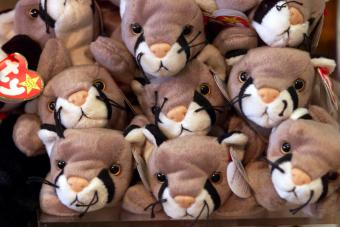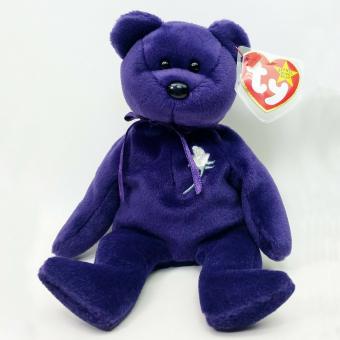
You don't have to be a '90s baby to be able to recognize a Beanie Baby's classic silhouette from tons of feet away. Like the infamous Furby and Tamagotchi toys, Beanie Babies have recently undergone a resurgence as the Millennials who once had their beds piled high with these stuffed animals have reached the age to be having kids old enough to fall in love with Beanie Babies themselves. Before you hand over that box of your childhood memories to the closest kid in your life, take some time to check each and every tag to discern your Beanie Baby values and see which ones, if any, you should keep for yourself.
Factors That Determine Beanie Babies' Value
While most Beanie Babies you find aren't actually worth much more than what they originally sold for, a few releases can reach surprising amounts at auction. To discover which types of Beanie Babies normally go for these larger amounts, you'll need to check over your collection for several specific factors including market desirability, their condition, their rarity, and where you're thinking of selling it.
Desirability and the Buyers' Market
When the Beanie Baby craze was in full swing, it wasn't unusual for a particularly popular Beanie to sell for hundreds of dollars. People are willing to pay a bit more for ones that pull on their heartstrings, so a popular character that appeals to a person's inner child can fetch much more than a less desirable one. It's hard to say exactly what factors make a particular stuffed animal valuable at a specific time, but it's undeniable that different types of toys fluctuate in popularity over the years within collectors communities. So, it's important to keep on top of what's selling quickly and what's lingering so that you know when it's right to sell that prized Beanie Baby you've been holding on to for years, as well as how to sell Beanie Babies to ensure your profit.

Condition
Like all antiques and collectibles, condition is an incredibly important factor when it comes to determining Beanie Baby value. Toy collectors will certainly look at the condition of an item before even thinking about purchasing it. Some of these condition grades include:
- Mint - The character shows no signs of wear or defects and has the both the hang tags and tush tags intact.
- Near Mint - The tags might be slightly worn or bent but the character is in perfect condition. These sell for 80% to 90% of the price of the same toy in mint condition.
- Excellent - The tag may be creased or worn, but the character itself is still be in perfect condition. The fair price on a Beanie in excellent condition would be about 65% to 75% of the mint price.
- Very Good - The tags are very worn, torn, or missing completely, but the character is still in perfect condition. You can expect to price this at about 40% to 60% of the mint price.
- Damaged or Played With - These encompass the Beanie Babies that were played with. The fabric might be worn, tags may be missing, or there may be need of/evidence of repairs. You can expect this category to sell for about 5% to 25% of the mint price.
Rarity
In order to encourage their continued popularity, Beanie Babies were often retired after a certain number of them were produced. A retired Beanie Baby will usually fetch more at auction than one in current production since there's a finite number of that character available. To check and see if your Beanie is retired, you can check the Ty website.
On top of determining if your character is out of production, you also need to look at the hang tag (if it's still intact) to see which generation of Beanie your toy is. Since these toys were made in "generations," the first generation is generally more valuable than the ones that follow, much like first edition books are more valuable than later publications are. The very first generation of Beanie Babies was released in 1993 and is considered among the most valuable.
Sales Location
You can expect to get a higher price for a Beanie Baby at an auction specifically marketed to Beanie collectors than you can at a garage sale or on an online platform. While it may take longer to sell through a Beanie Baby auction house or a website for collectors, the higher price you can get it worth the wait for many sellers.
Resources to Help You Evaluate Your Beanie Babies
When it comes to evaluating Beanie Babies on your own, your first step is to pick up a good price guide, and one of the most current ones is a collection of several ebooks from a website dedicated to creating Beanie Babies price guides. According to the website, these price guides were compiled by three seasoned Beanie Baby collectors with over 20 years of experience and include pricing information pertaining to Beanie Babies in all types of conditions.

Other ways to estimate the price of your Beanie is to check a few online venues to see what the character you have has recently sold for, such as on:
- eBay - eBay isn't only an outstanding tool for collecting items, but you can look through their past sales history of specific items to see what people are actually willing to pay for your goods. This gives you 'boots on the ground' knowledge about the current auction market and whether your Beanie Babies are going to sell for their full value price.
- World Collectors - World Collectors is constantly updating their website with current news relating to Beanie Baby production and sales; if you keep up with World Collectors, you'll be able to stay on top of all of the hot deals before the market gets over-saturated with the newest trendy toy.
Scour Your Collection for These Valuable Beanie Babies
Thanks to the shocking number of Beanie Babies that were manufactured during their heyday in the 1990s and early 2000s, it turns out that most of the most expensive Beanie Babies available on the current market are those with some sort of error. From misprinted tags to rare colors, the true value is in these vintage Beanie Baby 'rejects.'

- Autographed Democratic 'Lefty' Beanie Baby - Lefty the donkey, and its elephant partner, Righty, were released as two political stuffed animals in the Beanie Baby line. A few of these Lefty bears have come to auction having been signed by Hillary Clinton, making them valuable for their celebrity signatures and worth a few thousand dollars.
- Errors Valentino bear - Valentino was a popular white bear with a Valentine's Day inspired theme that occasionally experienced errors during manufacturing. For example, this one sold for $350 and had PVC pellets as its filling and brown buttons instead of its standard configuration.
- Summer of '99 Woodstock bears- Commemorative bears also sell for a few hundred dollars thanks to their limited runs. For instance, this pair of Woodstock '99 bears--of which only 10,000 were made--sold for $500.
- Wallace bear - Retired Beanie Babies also make up a substantial portion of the current market, with bears like Wallace (having been retired in 1999) selling for both hundreds and thousands of dollars. This specific Wallace recently sold for $2,500 at auction.
- Princess the Bear - Princess the Bear is the quintessential Beanie Baby that most people think of when they envision the most valuable of these collectible stuffed animals. Unfortunately, the $60,000+ legendary bids aren't realistic in the current market; rather, you'll find a lot of sellers unsuccessfully trying to get their Princess bears sold for thousands of dollars.
- Peanut the Elephant royal blue edition- Peanut the elephant, with its royal blue coat, is a unique limited color run of a small manufacturing batch. Yet, this quaint blue elephant represents a common occurrence in the Beanie Baby collectors market--one where offers for $4,000 show up alongside ones for $19.99 simultaneously.
Ways to Protect Your Beanie Babies' Value
Of course, if you have a collection of Beanies, you'll want to protect your investment and their value by taking good care of them. Hang tag covers can keep the tags stay in pristine condition, while displaying them in a glass front case out of direct sunlight will keep the Beanies' coats bright and fresh. This goes without saying, but if you're planning on keeping these toys as collectibles, then they shouldn't be played with, as this can significantly depreciate their value.

Beanie Babies Are Just a '90s Kids Thing
Whether you're a true '90s kid or you raised a '90s kid yourself, chances are high that you had plastic bins filled with all of the multi-colored, ear-tagged Beanie Babies that seemed inescapable during the last decade of the 20th century. Although not every extant Beanie Baby you find at the thrift store is worth more than its $2 ticket price, a fair few can sell for hundreds or thousands of dollars to an avid collector. So, check your childhood collection's ears for misprinted tags and other manufacturing errors to find the true cream of the crop.







